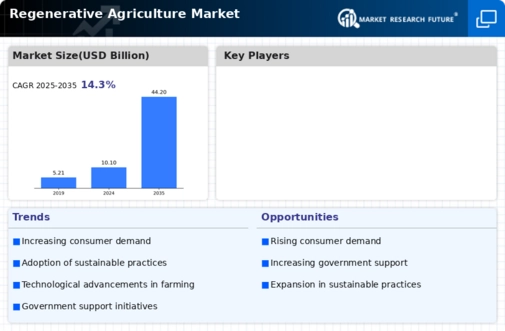Leading market players are investing heavily in research and development to expand their product lines, which will help the Regenerative Agriculture market, grow even more. Market participants are also undertaking a variety of strategic activities to expand their footprint, with important market developments including new product launches, contractual agreements, mergers and acquisitions, higher investments and collaboration with other organizations. To expand and survive in a more competitive and rising market climate, the Regenerative Agriculture industry must offer cost-effective items.
Manufacturing locally to minimize operational costs is one of the key business tactics used by manufacturers in the Regenerative Agriculture industry to benefit clients and increase the market sector. In recent years, the Regenerative Agriculture industry has offered some of the most significant advantages to the environment, farmers and society as a whole.
Major players in the Regenerative Agriculture Market, including Nestle SA (Switzerland), Danone SA (France), General Mills, Inc (US), Cargill Incorporated (US), Unilever PLC (United Kingdom), Grounded (South Africa), Soil Capital Belgium SPRL (Belgium), Indigo Ag, Inc (US) and Serenity Kids (US) are attempting to increase market demand by investing in research and development operations.
Nestle SA, a prominent food and beverage manufacturer, offers a wide range of products, including baby food, bottled water, cereals, chocolates, coffee and culinary items, among others. The company also caters to plant-based foods, dairy products, ice cream and pet care. Nestle's diverse product portfolio includes popular brands such as Nescafe, Nespresso, Maggi, Kit Kat and Purina, among others. Operating globally, Nestle has a significant presence across Asia, Oceania, the Americas, Europe, the Middle East and Africa, with its headquarters in Vevey, Waadt, Switzerland.
In July 2023, Nestlé initiated a project aimed at assisting wheat farms in adopting regenerative agriculture practices within the supply chain for its DiGiorno pizza brand. This initiative aims to enhance biodiversity, reduce water and energy consumption, minimize fertilizer usage and enhance soil health and fertility while addressing the impacts of climate change.
General Mills Inc. is a leading manufacturer and marketer of branded consumer foods, offering a diverse range of products, including grains, fruits, savories, nutrition bars, frozen snacks, cereals, pet food, dough products, baking mixes, yogurt and premium ice cream. The company's product lineup also includes convenient meal options like meal kits, ethnic meals, pizza, soup and breakfast items. General Mills markets its products under various well-known brand names such as Cheerios, Chex, Cocoa Puffs, Fiber One, Go-Gurt, Gold Medal and many others.
Operating across Asia, the Middle East, Africa, Europe, North America and Latin America, General Mills is headquartered in Minneapolis, Minnesota, USA. In June 2022, General Mills partnered with Regrow Agriculture to monitor agricultural practices and their environmental impacts across 175 million acres of farmland in North America, Latin America and Europe.


